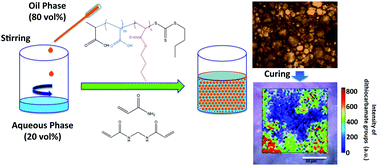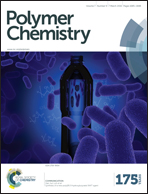Preparation of inverse polymerized high internal phase emulsions using an amphiphilic macro-RAFT agent as sole stabilizer†
Abstract
Oil-in-water (‘inverse’) High Internal Phase Emulsions (HIPEs) have been prepared using an amphiphilic macro-RAFT agent with toluene as the internal dispersed phase (∼80 vol%) and an aqueous monomer solution as the continuous phase. The water phase consisted of the monomers acrylamide (AM) and N,N′-methylenebisacrylamide (MBAM), an initiator as well as the amphiphilic macro-RAFT agent, that is 2-(butylthiocarbonothioylthio)-2-poly(n-butyl acrylate)-b-poly(acrylic acid), which was used as an anionic polymeric surfactant. The presence of these amphiphilic species allowed the successful preparation of a polyHIPE upon polymerization. The effect of concentration of macro-RAFT agent, pH, initiator, hexadecane as an organic modifier and the polymerization temperature on the morphology of the resulting porous materials was investigated. Varying the lengths of the hydrophilic and hydrophobic blocks of the macro-RAFT agent resulted in polyHIPEs with different porous structures. The presence of RAFT functionality in the polyHIPE was confirmed by elemental analysis, EDX-SEM, Raman and FT-IR spectroscopies. Raman mapping revealed full coverage of the void walls with dithiocarbamate groups.


 Please wait while we load your content...
Please wait while we load your content...